地鐵刷卡、上下班門禁打卡、高鐵進(jìn)站刷身份證、Apple Pay 購(gòu)物……這些日常使用場(chǎng)景,都使用了 NFC 非接觸式識(shí)別和互聯(lián)技術(shù),極大地方便了人們的生活。
不過(guò),目前市面上常見(jiàn)的NFC無(wú)線讀卡器都使用 WIFI或藍(lán)牙進(jìn)行數(shù)據(jù)傳輸,功耗較高、且傳輸距離有限。而如果采用 LoRaWAN?傳輸,則可以解決上述問(wèn)題。事實(shí)上,基于 LoRaWAN?的 NFC 讀卡器優(yōu)點(diǎn)突出:
1、LoRaWAN?的傳輸距離遠(yuǎn)、接收靈敏度高、且功耗低
2、采用LoRaWAN?無(wú)線傳輸?shù)淖x卡器安裝部署方便
3、能使用電池供電、可持續(xù)使用半年以上。
本文將通過(guò)瑞科慧聯(lián)的模塊化開(kāi)發(fā)套件 WisBlock 教大家快速搭建一個(gè)支持LoRaWAN?的無(wú)線讀卡器,讓這個(gè)讀卡器讀到電子標(biāo)簽數(shù)據(jù)時(shí),可以自動(dòng)將數(shù)據(jù)上傳到 LoRaWAN?服務(wù)器上。WisBlock 其實(shí)是一個(gè)物聯(lián)網(wǎng)解決方案設(shè)計(jì)生態(tài)系統(tǒng),由可拼接的模塊和易于使用的軟件工具組成,可加快物聯(lián)網(wǎng)產(chǎn)品生產(chǎn)周期、縮短上市時(shí)間。
搭建 LoRaWAN?NFC 讀卡器概述
本次搭建使用的硬件是瑞科慧聯(lián)(RAK)的 WisBlock 套件,MCU 選擇的是RAK4631WisBlock Core 模塊,該模塊采用強(qiáng)大的 Nordic nRF52840 MCU,可以支持藍(lán)牙 5.0(藍(lán)牙低能耗),以及 Semtech最新的 LoRa?收發(fā)器 SX1262,支持 LoRa?和藍(lán)牙兩種通信模式。
該 NFC 還選擇了 WisBlock 套件的 RAK13600 NFC 讀卡器模組,它使用的是 PN532芯片,可以支持 ISO/ICE 14443A/B 卡類型的讀寫,而且還搭配了一個(gè)蜂鳴器模組 RAK18001,當(dāng) NFC 刷卡有效時(shí),蜂鳴器會(huì)發(fā)出響聲提醒。
對(duì)了,該 NFC 讀卡器的搭建還會(huì)使用到瑞科慧聯(lián)(RAK)的低代碼開(kāi)發(fā)平臺(tái) RUI3,它為 WisBlock 提供包含傳感器驅(qū)動(dòng)接口、無(wú)線發(fā)送接口等豐富的 API接口函數(shù),這樣我們只需要寫少量的應(yīng)用代碼就可以完成此產(chǎn)品搭建了。
硬件電路搭建
硬件準(zhǔn)備
首先我們需要準(zhǔn)備 RAK4631 模塊、RAK5005-O 底板、RAK13600 NFC 讀卡器、RAK18001 蜂鳴器、兩張 ISO 14443B 卡、一根 LoRa?天線、一根 NFC天線、一個(gè) Unify 外殼、一根藍(lán)牙天線(安裝在外殼內(nèi))。
 RAK4631 模塊、RAK19007 底板、RAK13600 NFC 讀卡器等硬件準(zhǔn)備
RAK4631 模塊、RAK19007 底板、RAK13600 NFC 讀卡器等硬件準(zhǔn)備硬件組裝
把 RAK4631 模塊扣在 CPU SLOT 的位置,RAK13600 扣在 IO SLOT 的位置,RAK18001 扣在 SLOT A(或者SLOT B),并且使用螺絲把模組固定。
連接NFC天線、LoRa?天線、藍(lán)牙天線,并安裝至外殼中。硬件組裝完成之后就可以進(jìn)行軟件設(shè)置。

軟件環(huán)境搭建
在Arduino IDE中添加 RAK4631-R 開(kāi)發(fā)板
打開(kāi) Arduino IDE,進(jìn)入“文件 > 首選項(xiàng)”
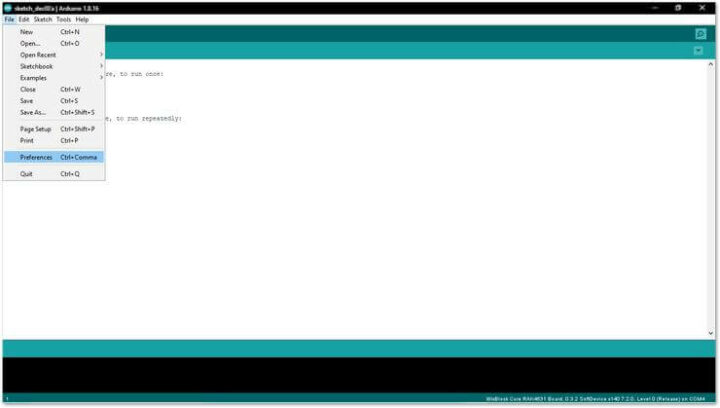 打開(kāi) Arduino IDE
打開(kāi) Arduino IDE單擊圖中圖標(biāo),修改“附加開(kāi)發(fā)板管理器網(wǎng)址”選項(xiàng),將 RAK4631-R WisBlock Core 添加中 Arduino 開(kāi)發(fā)板管理器中。
 在 Arduino IDE上修改“附加開(kāi)發(fā)板管理器網(wǎng)址”
在 Arduino IDE上修改“附加開(kāi)發(fā)板管理器網(wǎng)址”現(xiàn)在復(fù)制這個(gè) URL https://raw.githubusercontent.com/RAKWireless/RAKwireless-Arduino-BSP-Index/main/package_rakwireless.com_rui_index.json 并粘貼至下圖所示區(qū)域。如果已存在其他鏈接,將上述鏈接粘貼至新的一行。完成后,單擊“好”。
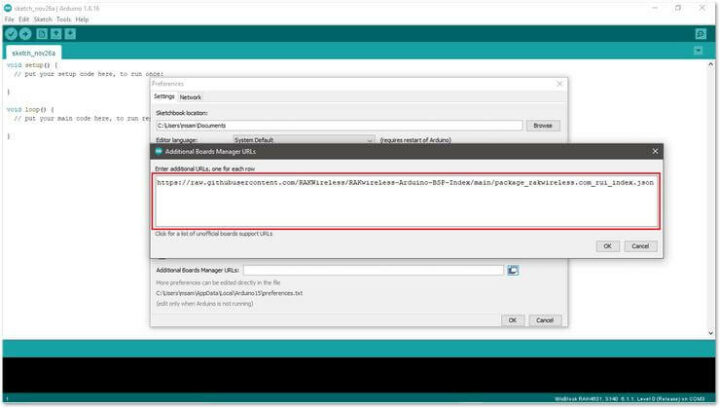 在Arduino IDE上粘貼復(fù)制好的URL
在Arduino IDE上粘貼復(fù)制好的URL重啟 Arduino IDE。 進(jìn)入“工具 > 開(kāi)發(fā)板:“RAK4631” > 開(kāi)發(fā)板管理器”。
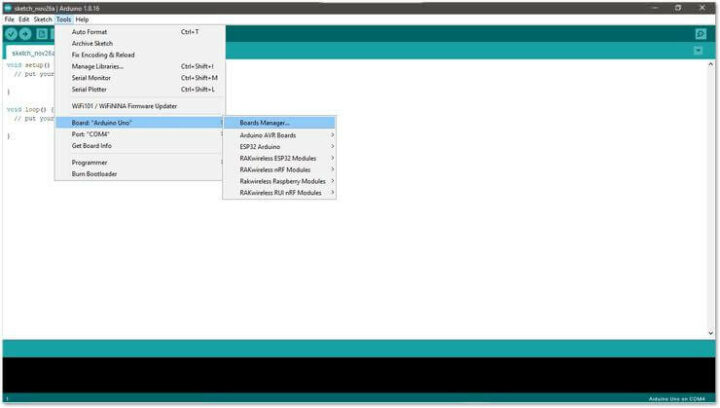 重啟Arduino IDE并執(zhí)行操作
重啟Arduino IDE并執(zhí)行操作在搜索框中輸入“RAK”,窗口會(huì)自動(dòng)出現(xiàn)可用的RAKwireless WisBlock Core Boards,選擇“RAKwireless RUI nRF Boards”并安裝。
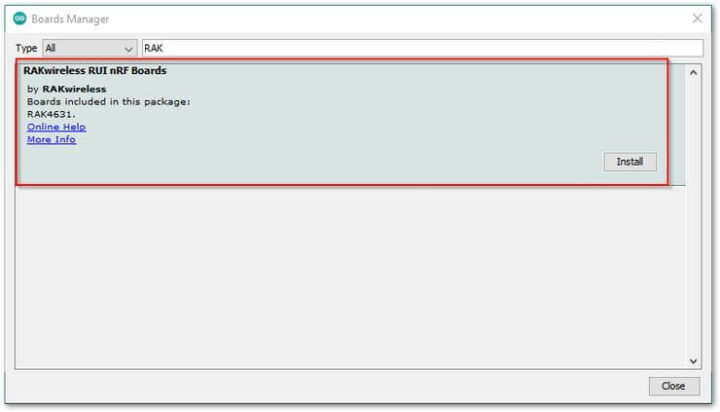 選擇并安裝 RAKwireless RUI nRF Boards
選擇并安裝 RAKwireless RUI nRF BoardsBSP 安裝完成后,根據(jù)圖中路徑選擇 RAKwireless WisBlock Core模塊。
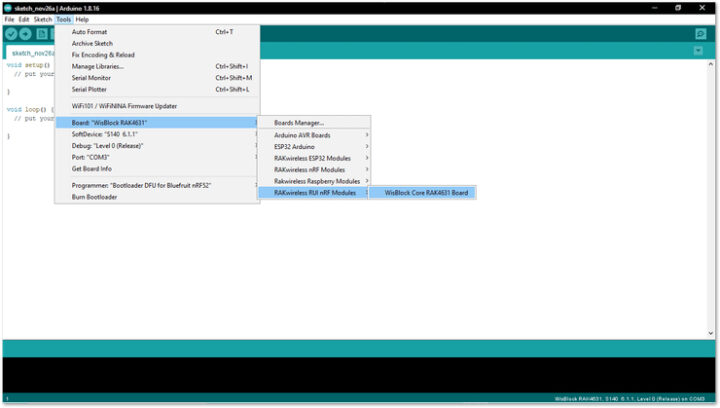 選擇 RAKwireless WisBlock Core 模塊
選擇 RAKwireless WisBlock Core 模塊安裝使用到的庫(kù)
現(xiàn)在安裝 RAK13600-PN532 庫(kù)和 Adafruit bus 庫(kù):
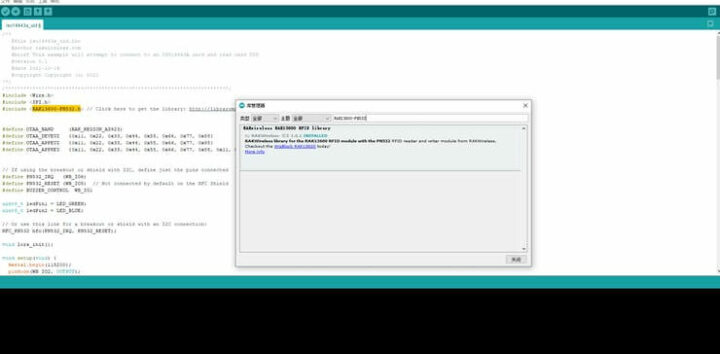 安裝 RAK13600-PN532 庫(kù)
安裝 RAK13600-PN532 庫(kù)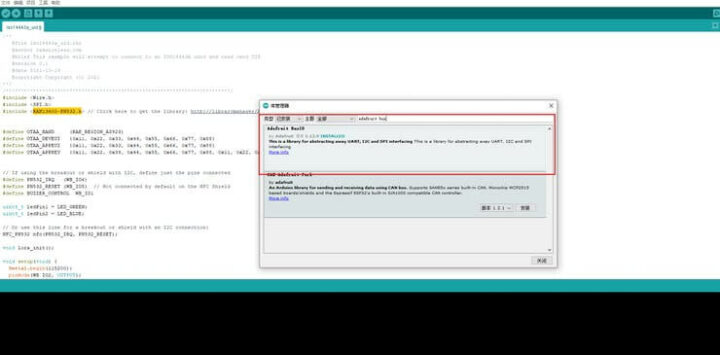 安裝 Adafruit bus 庫(kù)
安裝 Adafruit bus 庫(kù)代碼開(kāi)發(fā)
LoRaWAN?部分的初始化,此函數(shù)可以初始化協(xié)議棧的所有參數(shù),入網(wǎng)方式是OTAA,用戶需要根據(jù)自己的頻段,入網(wǎng)參數(shù)修改此宏定義,代碼中使用的頻段是 AS923。
/************************************* LoRaWAN band setting: RAK_REGION_EU433 RAK_REGION_CN470 RAK_REGION_RU864 RAK_REGION_IN865 RAK_REGION_EU868 RAK_REGION_US915 RAK_REGION_AU915 RAK_REGION_KR920 RAK_REGION_AS923 *************************************/ #define OTAA_BAND (RAK_REGION_AS923) #define OTAA_DEVEUI {0x11, 0x22, 0x33, 0x44, 0x55, 0x66, 0x77, 0x88} #define OTAA_APPEUI {0x11, 0x22, 0x33, 0x44, 0x55, 0x66, 0x77, 0x88} #define OTAA_APPKEY {0x11, 0x22, 0x33, 0x44, 0x55, 0x66, 0x77, 0x88, 0x11, 0x22, 0x33, 0x44, 0x55, 0x66, 0x77, 0x88} void lora_init()
蜂鳴器采用的是 PWM 控制,所以要記住在未使用蜂鳴器時(shí),記得關(guān)閉輸出。
pinMode(BUZZER_CONTROL,OUTPUT); noTone(BUZZER_CONTROL);
NFC 芯片初始化代碼,采用 IIC 通信協(xié)議,初始化結(jié)束后,就可以使用 NFC的刷卡功能了。
nfc.begin(); uint32_t versiondata = nfc.getFirmwareVersion(); if (! versiondata) { Serial.print("Didn't find PN53x board"); while (1); // halt } // Got ok data, print it out! Serial.print("Found chip PN5"); Serial.println((versiondata >> 24) & 0xFF, HEX); Serial.print("Firmware ver. "); Serial.print((versiondata >> 16) & 0xFF, DEC); Serial.print('.'); Serial.println((versiondata >> 8) & 0xFF, DEC); // Set the max number of retry attempts to read from a card // This prevents us from waiting forever for a card, which is // the default behaviour of the PN532. nfc.setPassiveActivationRetries(0xFF); //configure board to read RFID tags nfc.SAMConfig(); Serial.println("Waiting for an ISO14443A card");
每間隔 1 秒循環(huán)讀取是否有 NFC 卡存在,如果讀取 ID 成功,蜂鳴器會(huì)響 150 毫秒左右,然后發(fā)送卡 ID 到 LoRaWAN?服務(wù)器上。
void loop(void) { boolean success; uint8_t uid[] = { 0, 0, 0, 0, 0, 0, 0 }; // Buffer to store the returned UID uint8_t uidLength; // Length of the UID (4 or 7 bytes dep ending on ISO14443A card type) // Wait for an ISO14443B type cards (Mifare, etc.). When one is found // 'uid' will be populated with the UID, and uidLength will indicate // if the uid is 4 bytes (Mifare Classic) or 7 bytes (Mifare Ultralight) success = nfc.readPassiveTargetID(PN532_MIFARE_ISO14443A, &uid[0], &uidLength); if (success) { tone(BUZZER_CONTROL,4000); delay(150); noTone(BUZZER_CONTROL); Serial.println("Found a card!"); Serial.print("UID Length: "); Serial.print(uidLength, DEC); Serial.println(" byte s"); Serial.print("UID Value: "); for (uint8_t i = 0; i < uidLength; i++) { Serial.print(" 0x"); Serial.print(uid[i], HEX); } Serial.println(""); digitalWrite(ledPin1, HIGH); // LED turn on when input pin value is HIGH delay(150); digitalWrite(ledPin1, LOW); // /** Send the data package */ if (api.lorawan.send(uidLength, (uint8_t *) & uid, 2, true, 1)) { Serial.println("Sending is requested"); } else { Serial.println("Sending failed"); } // Wait 1 second before continuing delay(1000); } else { // PN532 probably timed out waiting for a card Serial.println("Timed out waiting for a card"); } }
數(shù)據(jù)日志
本地串口日志的信息如下所示:

RAK7268內(nèi)置LoRaWAN?服務(wù)器日志:

備注:全部源代碼如下所示
/** @file iso14443a_uid.ino @author rakwireless.com @brief This example will attempt to connect to an ISO14443A card and read card UID @version 0.1 @date 2021-10-14 @copyright Copyright (c) 2021 **/ /**************************************************************************/ #include #include #include // Click here to get the library: http://librarymanager/All#RAK13600-PN532 /************************************* LoRaWAN band setting: RAK_REGION_EU433 RAK_REGION_CN470 RAK_REGION_RU864 RAK_REGION_IN865 RAK_REGION_EU868 RAK_REGION_US915 RAK_REGION_AU915 RAK_REGION_KR920 RAK_REGION_AS923 *************************************/ #define OTAA_BAND (RAK_REGION_AS923) #define OTAA_DEVEUI {0x11, 0x22, 0x33, 0x44, 0x55, 0x66, 0x77, 0x88} #define OTAA_APPEUI {0x11, 0x22, 0x33, 0x44, 0x55, 0x66, 0x77, 0x88} #define OTAA_APPKEY {0x11, 0x22, 0x33, 0x44, 0x55, 0x66, 0x77, 0x88, 0x11, 0x22, 0x33, 0x44, 0x55, 0x66, 0x77, 0x88} // If using the breakout or shield with I2C, define just the pins connected #define PN532_IRQ (WB_IO6) #define PN532_RESET (WB_IO5) // Not connected by default on the NFC Shield #define BUZZER_CONTROL WB_IO1 uint8_t ledPin1 = LED_GREEN; uint8_t ledPin2 = LED_BLUE; // Or use this line for a breakout or shield with an I2C connection: NFC_PN532 nfc(PN532_IRQ, PN532_RESET); void lora_init(); void setup(void) { Serial.begin(115200); pinMode(WB_IO2, OUTPUT); digitalWrite(WB_IO2, HIGH); pinMode(BUZZER_CONTROL,OUTPUT); noTone(BUZZER_CONTROL); // initialize the LED pin as an output pinMode(ledPin1, OUTPUT); pinMode(ledPin2, OUTPUT); lora_init(); delay(300); while (!Serial) delay(10); Serial.println("Hello!"); nfc.begin(); uint32_t versiondata = nfc.getFirmwareVersion(); if (! versiondata) { Serial.print("Didn't find PN53x board"); while (1); // halt } // Got ok data, print it out! Serial.print("Found chip PN5"); Serial.println((versiondata >> 24) & 0xFF, HEX); Serial.print("Firmware ver. "); Serial.print((versiondata >> 16) & 0xFF, DEC); Serial.print('.'); Serial.println((versiondata >> 8) & 0xFF, DEC); // Set the max number of retry attempts to read from a card // This prevents us from waiting forever for a card, which is // the default behaviour of the PN532. nfc.setPassiveActivationRetries(0xFF); //configure board to read RFID tags nfc.SAMConfig(); Serial.println("Waiting for an ISO14443A card"); } void loop(void) { boolean success; uint8_t uid[] = { 0, 0, 0, 0, 0, 0, 0 }; // Buffer to store the returned UID uint8_t uidLength; // Length of the UID (4 or 7 bytes depending on ISO14443A card type) // Wait for an ISO14443B type cards (Mifare, etc.). When one is found // 'uid' will be populated with the UID, and uidLength will indicate // if the uid is 4 bytes (Mifare Classic) or 7 bytes (Mifare Ultralight) success = nfc.readPassiveTargetID(PN532_MIFARE_ISO14443A, &uid[0], &uidLength); if (success) { tone(BUZZER_CONTROL,4000); delay(150); noTone(BUZZER_CONTROL); Serial.println("Found a card!"); Serial.print("UID Length: "); Serial.print(uidLength, DEC); Serial.println(" bytes"); Serial.print("UID Value: "); for (uint8_t i = 0; i < uidLength; i++) { Serial.print(" 0x"); Serial.print(uid[i], HEX); } Serial.println(""); digitalWrite(ledPin1, HIGH); // LED turn on when input pin value is HIGH delay(150); digitalWrite(ledPin1, LOW); // /** Send the data package */ if (api.lorawan.send(uidLength, (uint8_t *) & uid, 2, true, 1)) { Serial.println("Sending is requested"); } else { Serial.println("Sending failed"); } // Wait 1 second before continuing delay(1000); } else { // PN532 probably timed out waiting for a card Serial.println("Timed out waiting for a card"); } } void lora_init() { // OTAA Device EUI MSB first uint8_t node_device_eui[8] = OTAA_DEVEUI; // OTAA Application EUI MSB first uint8_t node_app_eui[8] = OTAA_APPEUI; // OTAA Application Key MSB first uint8_t node_app_key[16] = OTAA_APPKEY; if (!api.lorawan.appeui.set(node_app_eui, 8)) { Serial.printf("LoRaWan OTAA - set application EUI is incorrect! \r\n"); return; } if (!api.lorawan.appkey.set(node_app_key, 16)) { Serial.printf("LoRaWan OTAA - set application key is incorrect! \r\n"); return; } if (!api.lorawan.deui.set(node_device_eui, 8)) { Serial.printf("LoRaWan OTAA - set device EUI is incorrect! \r\n"); return; } if (!api.lorawan.band.set(OTAA_BAND)) { Serial.printf("LoRaWan OTAA - set band is incorrect! \r\n"); return; } if (!api.lorawan.deviceClass.set(RAK_LORA_CLASS_A)) { Serial.printf("LoRaWan OTAA - set device class is incorrect! \r\n"); return; } if (!api.lorawan.njm.set(RAK_LORA_OTAA)) // Set the network join mode to OTAA { Serial. printf("LoRaWan OTAA - set network join mode is incorrect! \r\n"); return; } if (!api.lorawan.join()) // Join to Gateway { Serial.printf("LoRaWan OTAA - join fail! \r\n"); return; } /** Wait for Join success */ while (api.lorawan.njs.get() == 0) { Serial.print("Wait for LoRaWAN join..."); api.lorawan.join(); delay(10000); } if (!api.lorawan.adr.set(true)) { Serial.printf ("LoRaWan OTAA - set adaptive data rate is incorrect! \r\n"); return; } if (!api.lorawan.rety.set(1)) { Serial.printf("LoRaWan OTAA - set retry times is incorrect! \r\n"); return; } if (!api.lorawan.cfm.set(1)) { Serial.printf("LoRaWan OTAA - set confirm mode is incorrect! \r\n"); return; } /** Check LoRaWan Status*/ Serial.printf("Duty cycle is %s\r\n", api.lorawan.dcs.get()? "ON" : "OFF"); // Check Duty Cycle status Serial.printf("Packet is %s\r\n", api.lorawan.cfm.get()? "CONFIRMED" : "UNCONFIRMED"); // Check Confirm status uint8_t assigned_dev_addr[4] = { 0 }; api.lorawan.daddr.get(assigned_dev_addr, 4); Serial.printf("Device Address is %02X%02X%02X%02X\r\n", assigned_dev_addr[0], assigned_dev_addr[1], assigned_dev_addr[2], assigned_dev_addr[3]); // Check Device Address Serial.println(""); }
-
nfc
+關(guān)注
關(guān)注
61文章
1650瀏覽量
182117 -
RAK
+關(guān)注
關(guān)注
0文章
48瀏覽量
2263
發(fā)布評(píng)論請(qǐng)先 登錄
MAX14502高速USB至SD讀卡器,提供旁路控制技術(shù)手冊(cè)
MAXQ1741用于磁卡讀卡器的DeepCover安全微控制器技術(shù)手冊(cè)
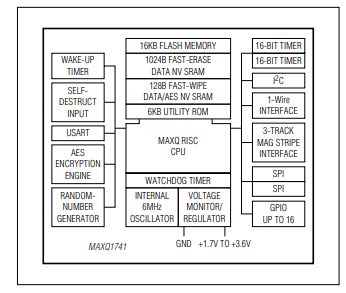
MAXQ1743 DeepCover安全磁卡讀卡器IC技術(shù)手冊(cè)
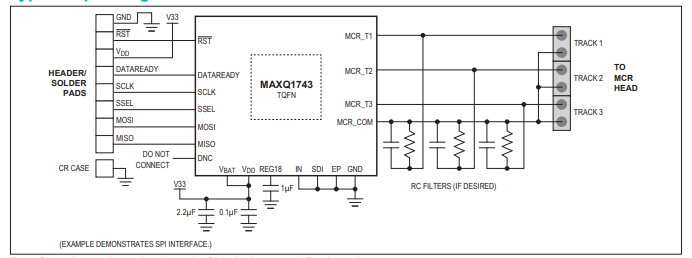
意法半導(dǎo)體ST25R系列NFC讀卡器新增車規(guī)產(chǎn)品
SE050是否可以完全依靠NFC電源運(yùn)行?
用于LEGIC Advant UID/序列號(hào)的NFC讀卡器,為什么無(wú)法讀取這些卡的UID/序列號(hào)?
可以使用基于PN7642的Pegoda智能卡讀卡器根據(jù)CCC要求定制NFC應(yīng)用嗎?
NFC卡的簡(jiǎn)單介紹及應(yīng)用
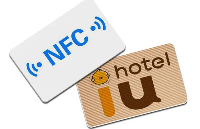
液顯ID讀卡器C#小程序開(kāi)發(fā)
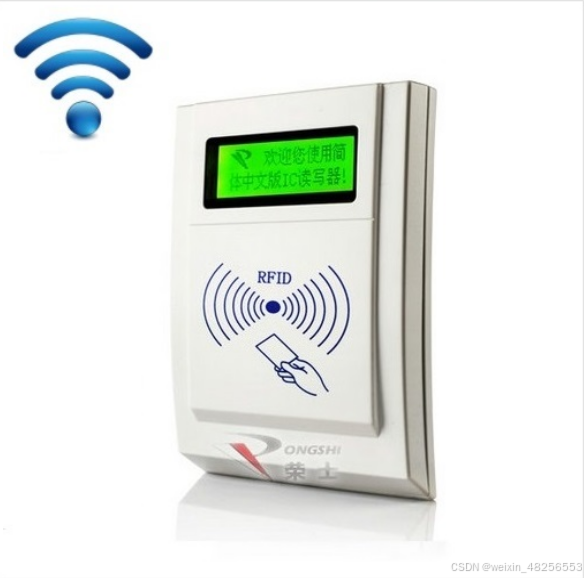
PPEC inside 超導(dǎo) / 磁鐵電源,以搭積木的方式快速滿足您的磁鐵供電需求
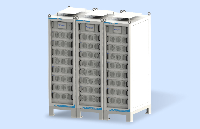
TRF7970A NFC讀卡器天線多路復(fù)用

AGV讀卡器在AGV自動(dòng)搬運(yùn)小車上應(yīng)用方案
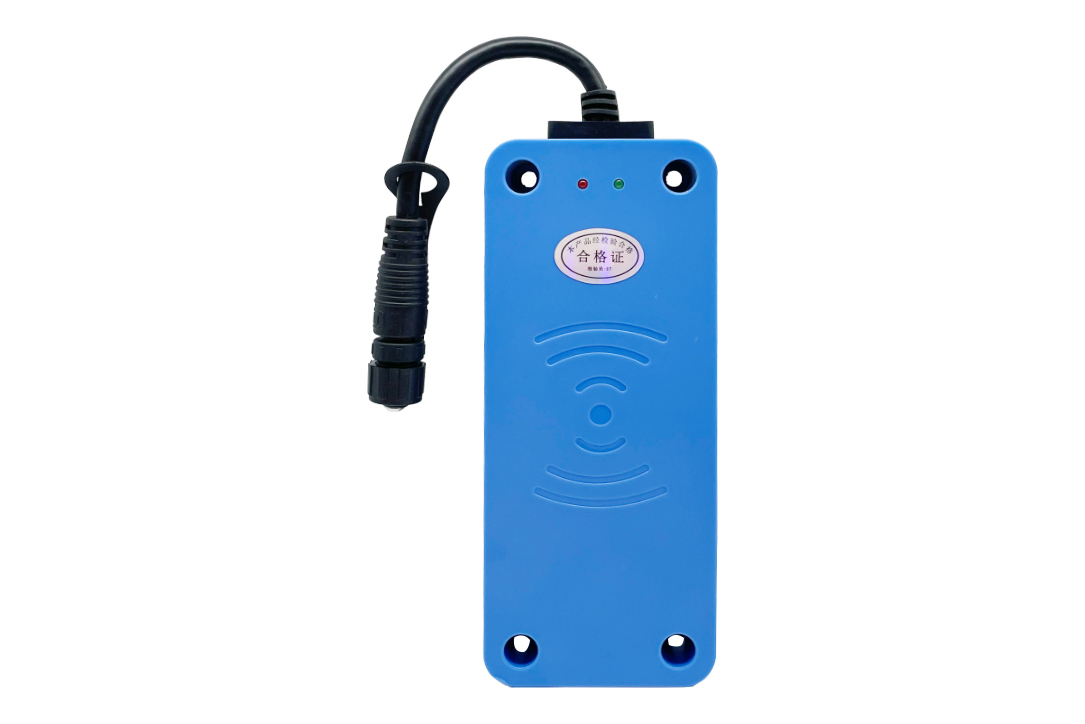





 用搭積木的方式自制一個(gè)NFC讀卡器
用搭積木的方式自制一個(gè)NFC讀卡器










評(píng)論